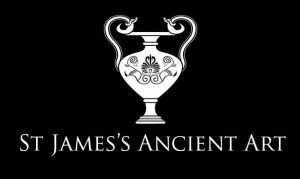The ‘manus fica’, “fig hand”, was an obscene hand gesture that was thought to represent female genitalia. Romans associated the fig with female fertility and eroticism, as the fruit was sacred to Bacchus. Whether made as an apotropaic gesture, worn as an amulet, or affixed to a larger object, the manus fica was used for magical protection against the evil eye. The pater familias, the head of the family, would make the manus fica sign during the Lemuria festival to ward evil spirits away from the household.
Phallic emblems are found on a wide range of Roman objects, from amulets to frescoes, from mosaics to lamps. Such symbols were a representation of fertility, as well as performing an apotropaic function. Some amulets, such as this example, presented extra loops from which small chains with extra pendants used to hang, creating elaborate compositions, similar to wind chimes, whose clinking warded off evil spirits.
The phallic deity was called Fascinus, from the Latin word ‘fascinare’, meaning “to cast a spell”. Charms and amulets shaped as phalluses were worn to invoke the god’s protection against evil spells, and were a common piece of jewellery in ancient Rome. According to Pliny the Elder, charms of this kind were worn even by babies and soldiers.










